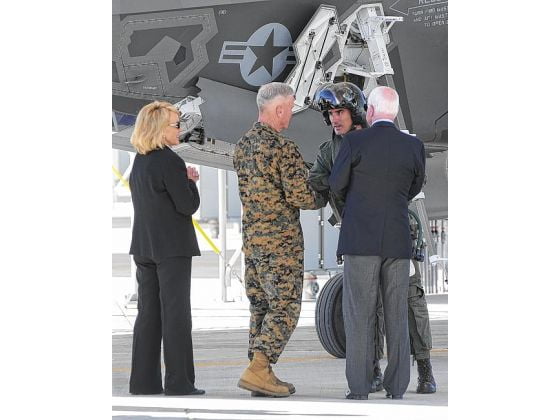2012-11-25 Second Line of Defense visited MAWTS a week prior to the official ceremony welcoming planes for the new F-35 squadron at the Marine Air Station at Yuma Arizona.
We visited MAWTS last year to discuss the evolution of training and tactics associated with the V-22 as well as the F-35.
https://sldinfo.com/preparing-for-the-f-35b-transition-mawts-re-shapes-its-curriculum/
MAWTS is where the Marines develop tactics and training for the various aviation assets working with overall Marine Corps operations. With the Marines integrating aviation into overall operations is the core operational reality. At MAWTS, the Marines shape their approach to innovation as they move forward, notably with new systems, or newly configured systems.
The squadron at Yuma will shake down the aircraft and get it operational.

As they do so, the pilots using the plane will work closely with MAWTS in shaping the new tactics and training associated with the aircraft.
Because this aircraft is a bundle of Harrier, Prowler, and F-18 capabilities with its own revolutionary foundation to doing air operations, the impact of using the aircraft will be central to the evolution of tactics and training.
Notably, Prowler pilots have been added to the MAWTS team in preparing for the F-35.
As one MAWTS instructor put it: “Prowler pilots are information warriors and this is a core element of what the F-35 is all about.”
With MAWTS working closely with the squadron, the development of tactics and training WHICH ARE AN INHERENT PART OF DEVELOPMENT for the plane, the squadron and the program, will be a center bull effort.
And this will be significant as the squadron moves out.
In a discussion with Clint “Boo Boo” Weber, the head of tac air at MAWTS, and with Captain Roger “Hazmat” Greenwood, the fit between the preparation of the aircraft for Marine Corps operations with the aviators was discussed.
SLD: Could you discuss the process of re-alignment of MAWTS personnel with the coming of the F-35?
Weber: When we discuss MAWTS-1 personnel to be involved with the JSF, we have to go back to when General Trautman was Deputy Commandant of Aviation. It was determined at that time that it was necessary to ensure that MOTS-1 was essentially at the forefront of operational test when it became appropriate.
And every DCA since that time has re-affirmed this approach. It has been felt that operational tests would be concurrent with tactics evaluation for the new jet.
As we have gone through this process we have tried to get the right guy for the right job. Hazmat brings significant background to MAWTS, which is crucial for where we are going. He has significant experience operating F-18s off of carriers and is a graduate of the USN’s Fighter Weapons School. He was an instructor at Top Gun with regard to tactics and training. His experience in the joint environment and operating at sea is a key part of where we are going in the future.
After MAWTS, he will go to Edwards to work on weapons integration and fusion integration. His background and experience is crucial for this next assignment as well and of course he will feed that back to us here at MAWTS as well.
Greenwood: I think the operational experience with the Navy will be important as the Marines insert F-35s into the force.
The Marines are in an interesting spot, as we will have the plane first and can provide some insights into how the tactics and operational concepts will change with the plane.
We can provide inputs to our Navy brethren with regard to these developments. We will be leading forward on the impact of the F-35 transition for our sister services.
See also the following:
https://sldinfo.com/the-f-35-squadron-at-yuma-the-next-phase-begins/
https://sldinfo.com/local-arizona-tv-weighs-in-on-the-yuma-f-35-squadron/
https://sldinfo.com/first-operational-f-35-squadron-ceremony-at-yuma-arizona/


